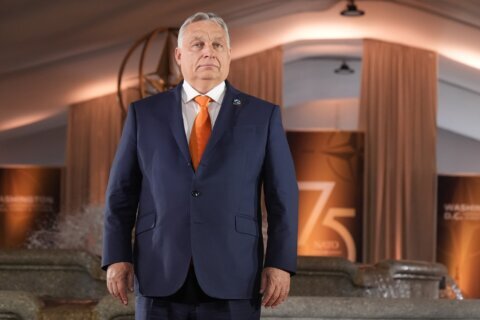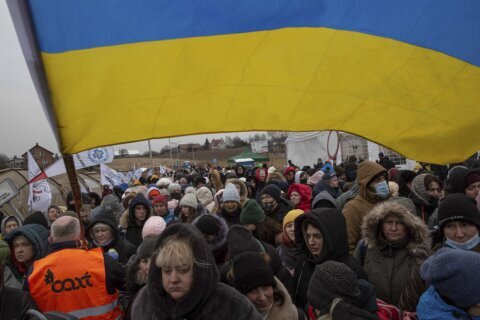KHARKIV REGION, Ukraine (AP) — Weeks after the decision allowing Ukraine to use U.S.-supplied weapons for limited strikes in Russian territory, the country is having some success in halting Russia’s new push along the northeast front, but military commanders are clamoring for restrictions on long-range missiles to be lifted.
Deteriorating battlefield conditions forced the U.S. to permit Ukraine to use Western-supplied artillery and rocket systems to defend the eastern city of Kharkiv by targeting border regions where the Kremlin’s forces assemble and launch attacks. The impact was swift: Ukrainian forces pushed Russian positions back, won time to better fortify their own positions and even mounted small offensive actions.
But commanders said that without the ability to use long-range guided missiles, such as ATACMS, their hands are tied.
“We could target (Russian) brigade command points and the entire northern grouping, because they are located 100 to 150 kilometers from the front line,” said Hefastus, an artillery commander in the Kharkiv region who goes by his callsign. “Normal ammunition can’t get at them. With this kind, we can do a lot to destroy their centers of command.”
The Ukrainian commanders interviewed spoke on condition that their callsigns be used, in line with brigade rules.
The U.S. expanded the scope of its policy to allow counterstrikes across a wider region Friday. But the Biden administration has not lifted restrictions on Ukraine that prohibit the use of U.S.-provided ATACMS to strike inside Russian territory, according to three U.S. officials familiar with the matter who spoke on condition of anonymity because they were not authorized to comment publicly. The U.S. began providing Ukraine with long-range ATACMS earlier this year, but with rules, including that they cannot be used to strike inside Russia and must be used within sovereign territory, which includes land seized by the Russians.
That prevents attacks on airfields and military infrastructure in Russia’s deep rear, underscoring a common Ukrainian complaint that Western allies anxious about potentially provoking Russia are undermining Ukraine’s ability to fight effectively.
Ukrainian officials are pushing U.S. allies to be able to strike particular high-value targets inside Russia using ATACMS, which can reach over 100 kilometers (62 miles).
“Unfortunately, we still cannot reach, for example, airfields and their aircraft. This is the problem,” Yehor Cherniev, deputy chairman of the parliamentary committee on national security, defense and intelligence, said earlier this month. “That’s why we are asking (allies) to lift the restrictions to use long-range missiles against limited military targets in the territory of Russia.”
Since late May, Ukraine has been able to target Russian troops and air defense systems 20 kilometers (12 miles) from the border in the Kharkiv region. Moscow opened a new front in the region on May 10, capturing village after village in a sweeping advance that caught Ukrainian troops unprepared.
Though not a panacea, the move has greatly slowed Russia’s momentum, even allowing Ukrainian troops to make advances along the northeast border, including recently recapturing areas southwest of Vovchansk, according to local reports. Brigades there said high mobility army rocket systems, or HIMARS, were fired hours after permission was granted, destroying an air defense complex outfitted to launch the deadly missiles.
At the time, the stakes were high as Ukrainian military leaders anticipated another assault designed to divert troops from other intense battlegrounds in the Donetsk region. First Deputy Defense Minister Ivan Havryliuk told The Associated Press that at least 90,000 Russian troops deep in Russian territory were gearing up for a new assault.
“The HIMARS were not silent for the whole day,” Hefastus said, recalling the first hours when permission was granted to use the rocket systems. “From the first days, Ukrainian forces managed to destroy whole columns of troops along the border waiting for the order to enter Ukraine.”
“Before, we couldn’t target them. It was quite complicated. All warehouses with ammunition and other resources were located a 20-kilometer distance beyond what we could hit,” he said.
The dynamics shifted almost immediately, allowing Ukrainian forces to stabilize that part of the front line. Soldiers near a strategic area north of Kharkiv where fighting to push Russian troops back is ongoing said enemy troops had moved positions several kilometers back. Such claims could not be independently verified.
“Tactics have changed” as a result of Ukraine’s improved striking ability, said Kalina, a platoon commander for the Khartia Brigade. Before, they were only able to hit incoming infantry assaults; now, they can employ more artillery against Russian firing points.
The U.S. decision came in the 11th hour, after much lobbying by Ukrainian officials and right as troops were preparing for combat in anticipation of Russia opening a new front in the northeast.
Ukrainian officials are hoping to convince American allies to allow the use of ATACMS against specific targets.
“It seems pretty absurd when the enemy is so actively advancing on our territory and striking with all types of missiles and calibers at Ukrainian territory and we cannot strike back inside the enemy’s territory where they hold logistics and supplies,” said Lys Mykyta, the commander of a drone company in the 103rd Territorial Defense Brigade.
But Ukrainian officials said only desperate battlefield conditions are likely to convince American officials to walk back the restriction.
The renewed invasion of the Kharkiv region, which drew in precious Ukrainian reserves, pushed the U.S. to have a change of heart on allowing self-defense strikes in Russian territory, Cherniev said.
“Probably, the decision about the ATACMS will also be changed based on the situation on the ground,” he said. “I hope the decision will be made as soon as possible.”
___
Associated Press writers Volodymyr Yurchuk in Kyiv, and Aamer Madhani, Matt Lee and Tara Copp in Washington, D.C., contributed to this report.
Copyright © 2024 The Associated Press. All rights reserved. This material may not be published, broadcast, written or redistributed.







